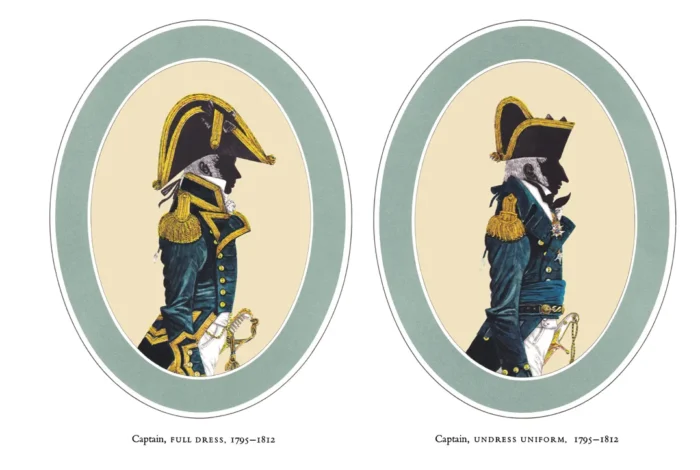(I) Captain, Full Dress
(II) Captain, Undress Uniform
£17.50
(I) Captain, Full dress, 1795-1812
(II) Captain, undress, 1795-1812
(scroll down for a more detailed Description)
Published 1965 © Hugh Evelyn Limited; drawn by John Mollo (1931-2017)
Size: c. 38 x 25 cm. [15″ x 10″] may vary slightly from printers’ cut 50 years ago
Printed on high white heavy cardstock 149 g/sm²
This is a STANDARD sized print – shipping is the same for 1 to 10 prints (based on largest print size in your order) – see Shipping & Returns
In stock
Description

I. Captain, Full Dress, 1795-1812: from a drawing of Sir Thomas Foley by Henry Edridge (1807), a coat at the Royal Museums, Greenwich and the pattern books of naval tailors, Welch and Stalker. The alteration to senior officer’s uniforms in 1795 led to abolition of the white lapels and cuffs which had been a feature of a captain’s uniform since 1748. His head was also beginning to take on a new appearance. Hair was being worn shorter at the back and over the ears, and powder and queues were on the way out. In the army, officers were wearing false whalebone queues, which tied round the neck under the coat collar, so that they could turn their heads independently of their pigtails, much to the astonishment of the beholder. Because of contact with the French Revolutionary armies the Army started wearing their cocked hats fore and aft’, and the Navy soon followed suit. By 1805 it seems to have been common practice in both services for all but the most senior officers.
II. Captain, Undress Uniform, 1795-1812: drawn from a painting of Sir Sidney Smith by J. Eckstein and a water colour of a senior captain by Antonad at the Royal Museums, Greenwich. Nelson was not the only eccentric: Captain Sir Sidney Smith is the subject of this plate. His distinguished early career was marred by a conceited manner. In 1790 he was present at the defeat of a Russian fleet in the Gulf of Viborg, was knighted by Gustavus, and awarded the Grand Cross of the Order of the Sword. He escaped from Paris, where he was held prisoner-of-war at the height of the Terror. Nelson disparagingly called him the ‘Swedish Knight’ when he served under Nelson in the Mediterranean; In 1799 he held the town of Acre against a French army commanded by Bonaparte himself, for two months, with only a handful of undisciplined Turks, and the seamen and marines from his two ships, Le Tigre and Theseus. Sir Sidney could claim to be the first Englishman to defeat Napoleon on land.
Additional information
| Weight | 0.0145 kg |
|---|---|
| Dimensions | 38 × 25.5 cm |





